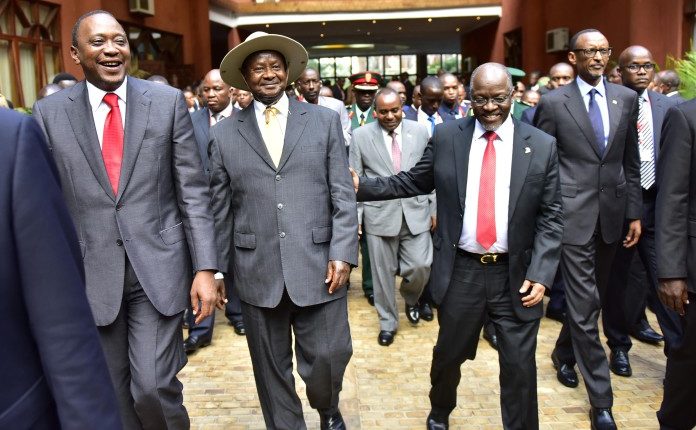If you are a dyed-in-the-wool East African recent developments in the region will have left you feeling quite distraught. “It would take a lot of bravery to assert that all is well,” says the regional publication The East African in its November 23 editorial.
The union, now in its 20th year, will look back at 2019 as a year it would rather forget. What with the ongoing crises in its two newest members, South Sudan and Burundi. The latter continues to shun regional summits citing all kinds of reasons, including its tiff with neighbour and fellow EAC member state Rwanda; while there’s no peace on the horizon yet for the former, also Africa’s youngest nation. Warlords Kiir and Machar seem hell bent on pushing that jewel of a country back into the dark ages.
Then there’s the bigger tiff between Uganda and Rwanda. Since the border closure by Rwanda in February relations between the two governments have ebbed to perhaps their lowest point in two decades. There are no signs a “friendship” agreement signed in Luanda, Angola will hold and few rule out the possibility of an all-out confrontation between the two if tensions continue.
That two champions of regional integration, in Kagame and Museveni, chose Luanda to be an arbiter in their disagreement, overlooking Arusha, almost sums up the crisis the regional body finds itself. The closest to a nudge from neighbours Kenya and Tanzania came in remarks by Kenyan deputy president William Ruto who while speaking at a summit in Kampala in March described the border closure as “retrogressive”. Otherwise, presidents Magufuli and Uhuru Kenyatta have preferred public silence on the matter.
This is the state the community finds itself going on to its 20th birthday.
Yet, where the cynics may see looming disaster and a bloc hurtling towards an eventual breakup, the optimist will see an opportunity for stock-taking of the gains since the regional bloc’s revival in 2000.
The community has achieved two major pillars to the integration project since 2000, the customs union and common market. While we have toyed with a monetary union, and later, a political federation these two will be difficult to attain in the near future without a significant re-imagination of the EAC’s founding ideals.
In what you would call the EAC 2.0 (the version of the community that came into being in 2000), the biggest achievements have been in the area of trade and (to a great extent) free movement of East Africans within the community. While Kenya and Tanzania have taken turns at confiscating one another’s cattle; burned chickens destined to another’s market; and Uganda has had its sugar wars with Kenya; Rwanda its on-and-off border closures with Burundi and Uganda, intra-regional trade has improved greatly in the last two decades.
Take for example, the recent report on intra-regional trade that showed intra-regional trade in the region in 2018 stood at US$ 6 billion from about US$1.4 billion in 2000, and was growing despite setbacks like non-tariff barriers that still exist .
Rather interesting is that some of the biggest winners of the intra-EAC trade, Uganda and Rwanda, are the ones stocking the flames that threaten to reverse the gains of the last few decades.
On the social front, Tanzania’s bongo music has brought the region somewhat of a unique cultural identity and made Kiswahili cool for a number of young Africans. It will be hard for artistes in other parts of the region to avoid gravitating towards this form of expression, and we are already seeing signs in the likes of Eddy Kenzo, Sheeba and Jose Chameleone (who for ages has been a true embodiment of what you would call an East African). In the same way, Kampala’s parte contagion and care-free lifestyle have all but attained enviable status among our East African peers. Weekends in Kampala are very much an East African affair and lately festivals like Nyege nyege attract more Kenyans and Rwandans combined than Ugandans.
Which brings us to EAC 3.0.
Heading into its third decade, the challenges the region faces will be slightly different from the kind the UTAKE founder generation of Museveni, Moi and Mkapa had to grapple with. With the union expanding to accommodate more members we will soon run out of a sensible acronym for the membership, but that will be a small matter.
With trade firmly locking together the union’s 220 million strong market in 2030, next will be questions of identity. Who is an East African? What rights should they enjoy? Will the union stick to Kiswahili as the lingua franca?
All these are quite complicated matters that the current leadership in the region is not (and will not be, should they live to see 2030) competent enough to address, partly because of their historical baggage and worldview imposed on them by their experience. In short, the kind of bold thinking that triggered Museveni’s regional integration ambition (even proposing, some time in 1996, a union of East and Central Africa!) that eventually birthed the EAC in 2000; or Kagame’s pragmatism in pulling Rwanda into the union in 2007, is what, ironically, will hamper their ability to peer into the future East Africa 3.0 and take the leap of faith.
Both old men find themselves too risk averse to stare into 2030 with the kind of boldness and zeal as they did 20 years ago.
East Africa 3.0 will be driven by shared mentalities about being (East African) and less by the brick and mortar of physical borders, personal armies or a knack to jailing opponents. East Africans living in 2030 will find titles like Supreme Eternal Guide, for presidents, not only a relic from the stone age but quite disgusting as well. Joining the long list of relics, one hopes, will be the small Kenyan matter of tribal politics too.
Hongera Jumuiya!










